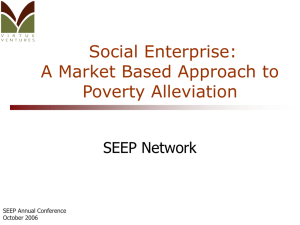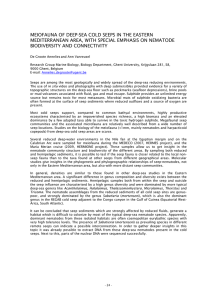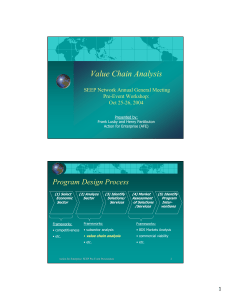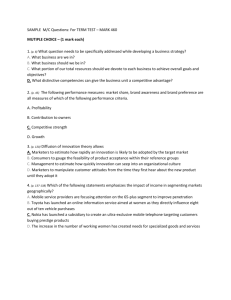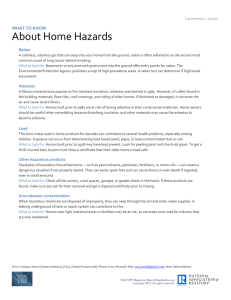Measuring Investment: A First Step in Social Return for Microfinance
advertisement
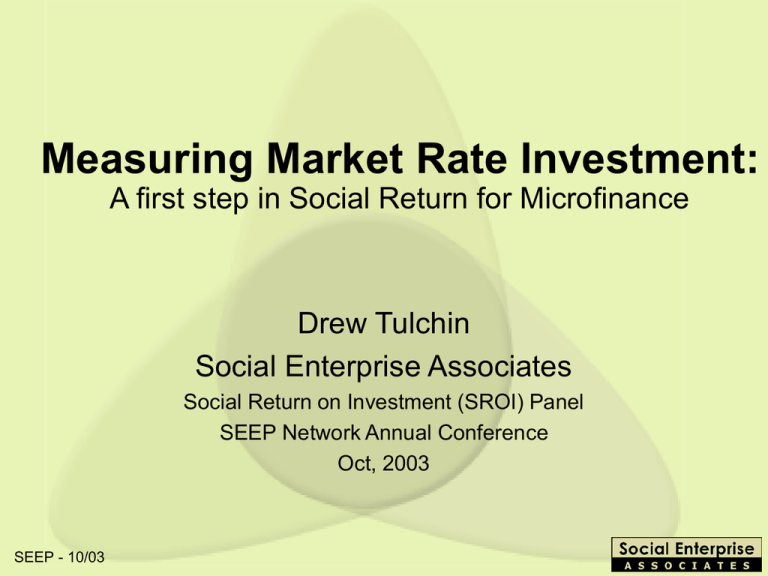
Measuring Market Rate Investment: A first step in Social Return for Microfinance Drew Tulchin Social Enterprise Associates Social Return on Investment (SROI) Panel SEEP Network Annual Conference Oct, 2003 SEEP - 10/03 SROI Panel: Measuring Market Rate Investment • • • • • • Introduction Definition, Value & Goals of Social Return Frameworks Measuring Investment Market Investment Measurement Examples – General – Specific: Prisma Microfinance • Q&A SEEP - 10/03 Introduction Who are you? What brought you here today? Who am I? Drew Tulchin, Social Enterprise Associates A network of professionals making communities better by applying business skills & sustainable practices. SEEP - 10/03 Definitions of Social Return More than one definition? Different emphasis directs our thinking Varied audiences suggests variety of solutions • Internal Economic Value generated – (s)ROI • Documented social value created – SroI • External Economic Value created – i.e. return provided to society SEEP - 10/03 Challenges of Social Return • • • • • • • Not well understood Hard to measure important elements Few tools exist No industry standard Takes lots of time Need to create proxies No critical mass, low cost/benefit Why bother? SEEP - 10/03 Value of Social Return Broadly (more obvious) What is its function? • • • • Marketing / PR Enhance impact measurements Tie to Socially Responsible Investment (SRI) Mobilize new investment/sources of cash into microfinance Specifically (less obvious) Who is the social return for? • Use by managers in decision-making • Segment SRI interested investors. Craft tailored messages to each, using social return for some • Consider social benefits from financial inputs (investment) SEEP - 10/03 Goals for Social Return • • • • Develop an industry metric & apply it uniformly Establish comparables (apples to apples) Aggregate Data (industry totals, vs. other sectors) INTERNAL audience: – • Easy to use, add value to operations EXTERNAL audience: – Easy to understand, add meaning to investment decision &/or evaluation SROI operating on two fronts: 1) 2) Undertake R&D to create social science valid standard Use existing available data for best use SEEP - 10/03 Goals for Social Return • • • • Develop an industry metric & apply it uniformly Establish comparables (apples to apples) Aggregate Data (industry totals, vs. other sectors) INTERNAL audience: – • Easy to use, add value to operations EXTERNAL audience: – Easy to understand, add meaning to investment decision &/or evaluation SROI operating on two fronts: 1) 2) Undertake R&D to create social science valid standard Use existing available data for best use SEEP - 10/03 Impact Framework United Way’s Logic Model Org.’s Mission Activities Outputs Outcomes Effect, impact & measurement related back to MISSION SEEP - 10/03 Source: United Way & Kellogg Foundation Community Goal Social Return Framework Adapted Logic Model Input (Investment) Activities Outputs Outcomes Effect, impact & measurement related back to INPUT as a return ratio SEEP - 10/03 Source: Soc. Ent. Assoc Microfinance and the Double Bottom Line, Ford Foundation Impact Premise Given the model, assuming the organization engages in same activities (& outcomes, outputs), market rate investment is the best input. Investment for social return: • Larger pool of money – ($1 trillion a day vs. donors’ est. $1 billion a year) • ‘More’ social benefit – ALL grant $ is social benefit based, investment $ is not • ‘Frees’ up grants for other uses – donors encouraged to take on higher risk activity SEEP - 10/03 Measuring Investment Sources for Analysis • Balance Sheet Measurement Tools • Weighted Average Cost of Capital (WACC) • Rating Reports • Mix Market • Operational & Financial Self Sufficiency (OSS/FSS) • Subsidy Dependency Index (SDI) • Market Efficiency Audit • Investment Measurement Are they SEEP - 10/03 Easy to use? Compelling for Investment? Operational & Financial Self Sufficiency (OSS/FSS) What they are. • SEEP Definition How they apply to Social Return. • OSS / FSS demonstrate financial success • Two examine question from different angles Challenges & Problems. Use = Mod Invest = Depends • Used for other purposes • Not complete application • What do numbers >100% mean here? SEEP - 10/03 Subsidy Dependency Index (SDI) What it is. • Amount an MFI must increase interest rates so operations are at breakeven / sustainable levels How it applies to Social Return. • SDI shows how far rates charged are from sustainable operating levels Challenges & Problems. • ‘Negative’ measure, little change is good • Difficult to understand • Its measurement is not central to social return SEEP - 10/03 Use = Low Invest = Low Market Efficiency Audit What it is. • Developed by David Korten, “When Corporations Rule the World” to provide transparency on corporate subsidies by measuring and displaying the subsidies corporations received in production of their products How it applies to Social Return. • Designed with corporate social responsibility in mind Not judgmental, geared towards transparency Challenges & Problems. • ‘Negative’ measure, 0 is good • Not known & used • Transferable to MFIs? Source: SEEP Korten, - 10/03David. “A Market Based Approach to Corporate Responsibility.” Use = Low Invest =Maybe Mod Investment Measurement What it is. • Hybrid: Korten’s transparency & SDI sustainability • Uses available information • Percentage an MFI’s capital is market rate investment How it applies to Social Return. • Demonstrative metric displays MFIs capital in concise fashion. Easy to count & compare Use = New Challenges & Problems. Invest = High • New concept • MFIs threatened by having a ‘low score’ • Already too much ‘noise’ in this area SEEP - 10/03 Measurement – General Example Assuming $100 in Total Capital Case 1 – All grants. 0 / 100 = 0% Case 2 – All investment. 100 / 100 = 100% Case 3 – All soft loans at 1/2 market rates. (100 x .5) / 100 = 50% Case 4 - $30 grants. $30 investment. $40 at 2/3 market rates. ((30 x 0) + (30 x 1) + (40 x .67)) / 100 = 57% SEEP - 10/03 Measurement – Specific Example • Prisma Microfinance: for-profit US international financial services company • Received SROI Award – Global Social Investment Forum (www.socialvc.net) • Completely funded by private investment Investment Measurement is 100% • SROI Measurement One year: Current portfolio x Investment Measurement Five years: Current portfolio value + incremental portfolio value each year x Investment Measurement @ NPV (No terminal value to be conservative) SEEP - 10/03 Conclusion • • • • Consider how SR to be used in the industry Value of a framework in the approach 4 Models considered here Investment Measurement emphasized – Not a solution, but a first step Key Questions for feedback: • It is logical? Does it have value? • How to improve it or what would be better? • This tool is one option; more work needed here • Recommended next steps? SEEP - 10/03 Thank you! Your feedback & participation is encouraged! Drew Tulchin Social Enterprise Associates www.SocialEnterprise.NET drew@SocialEnterprise.NET 617-872-0194 SEEP - 10/03
